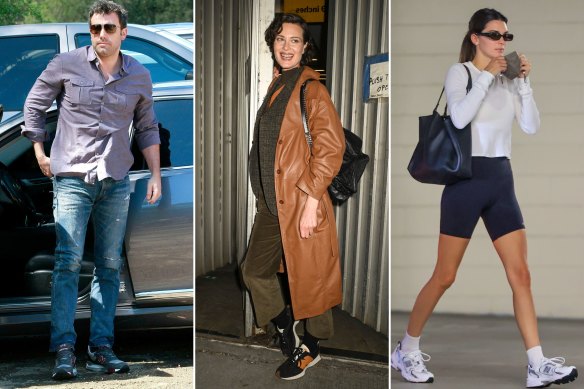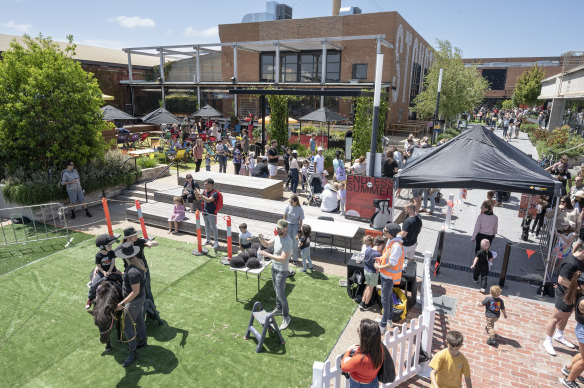Over the past five years or so, the company has been working on connecting with Millennial and Gen Z shoppers, with a particular focus on women’s shoes and apparel.
Celebrities such as Hailey Bieber and Kendall Jenner have been photographed wearing New Balance while running errands, while the company’s Instagram account has 7 million followers.

Actor Ben Affleck wearing New Balance sneakers in 2013. Supermodels Shalom Harlow and Kendall Jenner in New Balance sneakers.Credit: Getty
“The brand has gone through a massive digital transformation to allow us to connect with our consumer. It has been a big shift away from traditional marketing,” Howard said.
The boom in popularity for “heritage” or retro running shoes has also helped the company stay close to its roots.
“The key for us is remaining authentic to our brand.”
Loading
New Balance’s local team has grown to 70 employees, forcing the company to work hard to figure out where to fit them all in the office as the headcount has grown. The company’s entire team will soon relocate to Morris Moor, which was originally the site of the Phillip Morris manufacturing plant in Melbourne before it was redeveloped into a business park featuring onsite yoga and childcare.
Howard hopes the new location, which is reminiscent of New Balance’s global headquarters in Boston, will energise his staff for what’s next.
“It’s given us an opportunity to align with where our brand’s journey is heading and create a much more collaborative working space.”
Australian retail sales figures released on Friday showed turnover dropped by 0.8 per cent in June and sales of clothing and footwear dropped by 2.2 per cent compared with the previous month.
Brands in all industries have to fight increasingly hard for consumer dollars, though Howard believes the overall athletic-wear industry is still “very healthy”.

The group will move its Australian headquarters to the Morris Moor commercial development in Moorabbin.
“What we have found in financial crisis times is that walking and running can continue on. People put an emphasis on their mental health and wellbeing. History would say we are fairly strong as industry through these times.”
As a privately held global business, New Balance does not share revenue on a country-by-country basis, but the group’s managing director, Joe Preston, told Yahoo Finance this year that the business hit $US5.3 billion ($8 billion) last year, noting that all geographies had contributed to multiple quarters of record revenues.
The global sportswear and “athleisure” business has emerged from the COVID-19 pandemic in strong shape, with the worldwide athletic footwear market set to hit $US64.9 billion ($97.4 billion) by 2028, according to industry insights firm Statista.
Loading
Other Australian fitness brands have also strengthened over the past couple of years – athletic apparel business Lululemon’s profits ticked up to $14 million while its revenue was up 18 per cent to $241 million.
ASX-listed Super Retail Group has also had a strong performance from its Rebel stores, where demand for apparel for sports such as basketball has helped to lift sales. Rebel’s like-for-like sales growth for the first 43 weeks of the 2023 year was 10 per cent, the company said at a trading update in May.
The Australian Retailers Association warned on Friday that current economic conditions posed “a precarious environment for retailers”.
But Howard says New Balance’s lifestyle footwear and clothing brand is going from strength to strength, while the company’s long tenure makes it a well-known brand.
“We have 117 years of history and a major focus of the brand moving forward is to ensure our brand position in the running category.”
The Business Briefing newsletter delivers major stories, exclusive coverage and expert opinion. Sign up to get it every weekday morning.
Stay connected with us on social media platform for instant update click here to join our Twitter, & Facebook
We are now on Telegram. Click here to join our channel (@TechiUpdate) and stay updated with the latest Technology headlines.
For all the latest Business News Click Here
For the latest news and updates, follow us on Google News.
